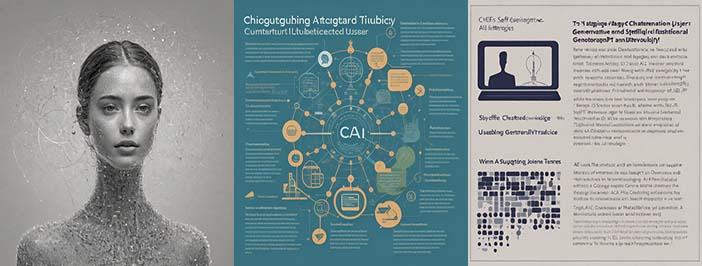
Interfacing Chat GPT: A Heuristic Approach for Improving Generative AI Literacies
Desiree Dighton East Carolina University
Introduction
In “Politics of the Interface” (1994), Selfe and Selfe imagined a future in which writing technologies would be shaped by computers and writing research. As the field of writing studies has developed alongside the evolution of personal computing, we've adapted our writing theory, practice, pedagogy, and research to social and technological transitions, maintaining a commitment to student agency. To support students in becoming effective writers in academic, professional, and social contexts, we emphasize flexible, individualized processes like brainstorming, researching, drafting, integrating feedback, revising, citing source material, and more. We've spent decades convincing our students that the process of generating a text is as valuable as and inseparable from final written products. Over the years, we've advocated for more inclusive writing pedagogies and assessment standards that value student writing processes and their written products. We've moved rubrics away from a "Standard" Written English and toward honoring students' home languages and linguistic diversity. As a field, we've largely embraced technologies as beneficial for helping students learn, assert agency, and write more effectively in our classrooms and beyond. Many of us eagerly adapt our writing pedagogies to technologies as they emerge, wanting our students to gain practice with innovations that may become important to their futures. In the age of Generative Artificial Intelligence (GAI) like ChatGPT, Selfe and Selfe’s call for writing studies to engage both “students and computer specialists to re-design/re-imagine/re-create interfaces” becomes a call for critical literacy development that takes on renewed urgency within our classrooms and beyond (p. 495).
Video Transcript
This video has no audio. A split screen shows a plain white background on the right with the words "Get Started" in bold above two blue buttons in the center: Log in and Sign up. The left side features a pale golden background and an animation of text instructions that ChatGPT can presumably assist with:
|
The Interface as a Site of Critical AI Literacies
Selfe and Selfe (1994) urged us to see interfaces as “an interested and partial map of our culture and as a linguistic and cultural contact zone that reveals power differentials” (p. 485). While Grabill (2003) acknowledged that interfaces may grant users access to technology that helps them solve problems, that access also shapes user behavior and attitudes toward dominant norms. Stanfill (2015) observed how interfaces act upon their users through their circulation and designs that lose their visibility and legibility as users gain greater access to underlying systems, causing interfaces to become frames we look through (Jones, 2021; Selfe & Selfe, 1994; Stanfill, 2015). Interfaces, like all designs, are never actually transparent or neutral, but instead carry dominant “values of our culture—ideological, political, economic, educational” (Selfe and Selfe, p. 485). Interface analysis opens opportunities for building critical literacies as analyzing the interface has potential to “unconceal” dominant values and illuminate ‘contact zones’ that limit and enable users unevenly through power differentials. In our classrooms and other communities, we can build critical literacies heuristically through interface analysis of generative AI (GAI) applications like ChatGPT. Such interface analysis should focus both on the materiality of interface design and its circulation. Doing so may advance awareness of what Selfe and Selfe identified as the interface’s ability to norm users to the dominant values and behaviors. These norms show up in interface features and “grand narratives which foreground a value on middle-class, corporate culture; capitalism and the commodification of information; Standard English; and rationalistic ways of representing knowledge” (p. 494).
As we rush to prepare students with GAI knowledge and skills, we should attend to building critical literacies that explore the power dynamics of GAI interface designs. It is through reimagining and redesigning technical aspects like interfaces that we can work against their dominant norming power and “avoid disabling and devaluing non-white, non-English language background students, and women” among other harms (p. 495). With this paper, I offer tactics for classrooms and other communities to develop interface heuristics as critical AI literacies. Pedagogically, taking a heuristic interface approach provides an adaptable framework for scaffolding critical student AI literacies, even as GAI and its interfaces change and writing instruction strives to adapt in precarious times.
Developing critical GAI literacies builds upon our field's established understanding of the integral relationship between technology, writing, literacy, and power (Gee, 2004; Hawisher & Selfe, 2000; Selber, 2004; Selfe, 1999; Yancy, 2003). With the recent public release of GAI applications like ChatGPT, groups like the MLA-CCCC Joint Task Force on Writing and AI urge us to use our expertise to develop literacies around “the nature, capacities, and risks of AI tools” (p. 7). To cultivate critical literacies, we can "unconceal" GAI's values and risks, in part, by analyzing the point of contact between these technologies and humans: interfaces. To begin, we can ask how a particular interface design guides our use and provides transparency about its processes, systems, and data. We can invite community discussions about how GAI circulates through public conversations like promotional materials, popular media, and everyday conversations. Getting at these dimensions—the technical and the cultural—are crucial to building critical AI literacies in our classrooms and other communities. The next section briefly describes my rationale for choosing ChatGPT as the GAI application under discussion and for dynamically adapting classroom interface heuristics to other GAI interfaces and community experiences.
The interface descriptions provided throughout this paper often reflect specific versions and times in ChatGPT's quickly changing design and functional history. To the degree possible, I’ve indicated specific versions and dates, but elements of ChatGPT’s interface and processes may have changed beyond or escaped the timing of this writing and the classroom activities described. Even though ChatGPT and other GAI designs will continue to change, historic descriptions and lived experiences of the interface help us track these changes and their embedded cultural values over time. Heuristic analysis should be adaptable to future iterations, other tools, and new communities. As a brief case study, I’ll share my experience developing interface heuristic analysis to build critical GAI literacies with undergraduate writing students during ChatGPT’s initial public release.
ChatGPT: A Conversational Interface
ChatGPT's widespread and rapid public proliferation hinged, at least in part, on its interface design. With ChatGPT, GAI could be accessed by any user who could type or otherwise enter human language conversationally into a text field. With its chatbot interface, typical features like tool bars, drop down menus, and action buttons like “submit” have been omitted to prioritize the chat window (See Figure 1 and Figure 2). While chatbots regularly appear on website interfaces to assist users in navigating sites, services, and information, GAI web-based applications like ChatGPT are chat-based interfaces. In other words, the human-like conversations that make public access to GAI web-based applications like ChatGPT possible are the conversational interfaces, allowing us to use our natural human language rather than typical interface features to access technological processes and data.


